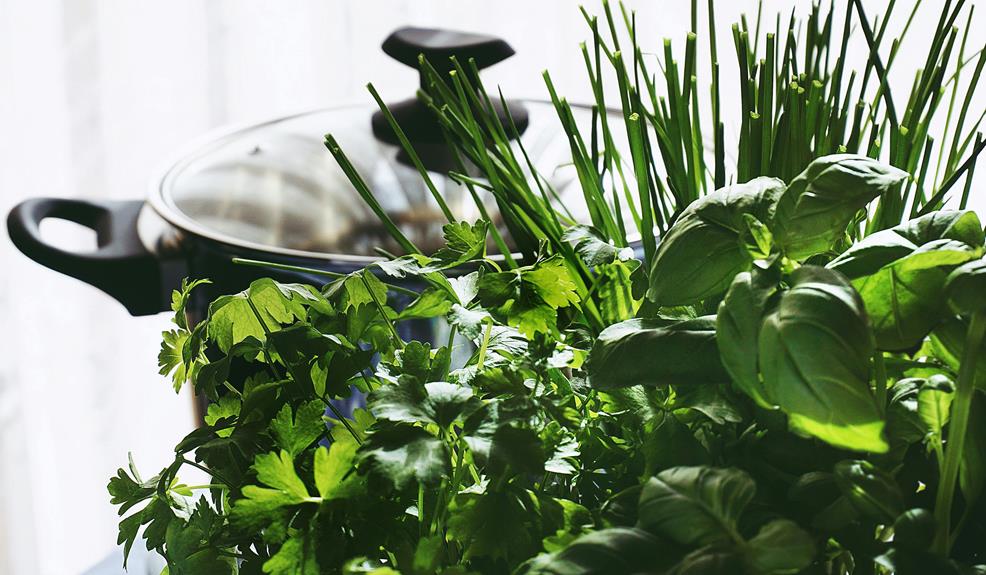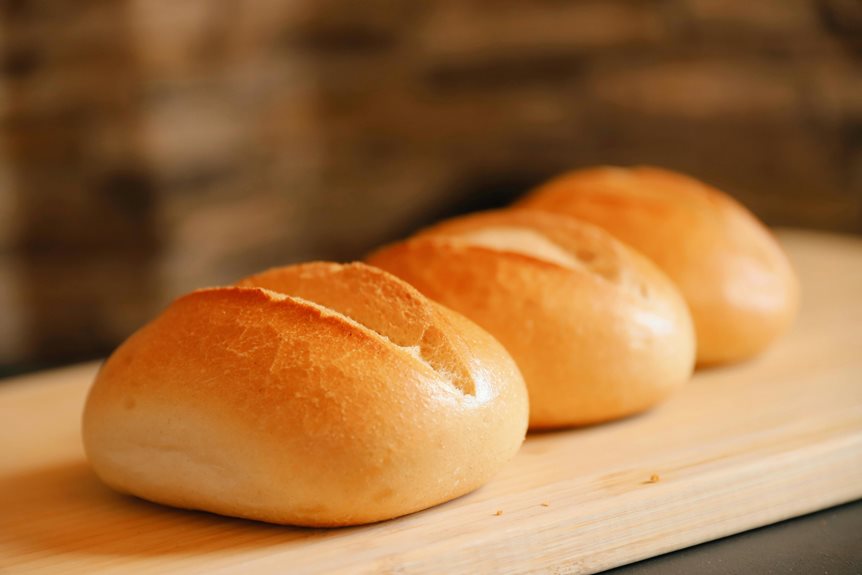Did you know that regularly pruning your chives can greatly enhance their growth and flavor, especially in an AeroGarden? When you're ready to prune, grab a pair of sharp scissors and aim to cut the tallest stalks down by about one-third, just above where the leaves branch off. This method not only keeps your chives looking tidy but also encourages a fuller, more productive plant. But there's a catch to getting it just right—knowing precisely when and how often to trim can make all the difference. Wondering about the best practices for timing and technique? Let's explore how to keep your chives thriving.
Key Takeaways
- Ensure the Aerogarden is unplugged and lights are adjusted for safe pruning.
- Use clean, sharp scissors or shears to cut chives about 6 inches tall.
- Target the oldest and tallest stalks, cutting one-third above where leaves meet.
- Regularly prune every few weeks to promote bushier growth and enhance flavor.
- Remove yellowed leaves and flower buds to maintain plant health and vigor.
Understanding Chive Growth
Chives thrive when they receive ample light and consistent moisture, especially in an Aerogarden setting. You'll find that these conditions not only promote growth but also enhance the flavor of your chives. To maximize your control over their development, understanding how chives grow from their roots up is key.
In your Aerogarden, chives begin as small, hardy seeds that quickly germinate in the ideal conditions you provide. They'll sprout thin, green shoots that evolve into hollow, round blades of grass-like leaves. As you monitor their progress, remember that chives are light lovers; the more they get, the better they'll perform. This is under your direct control with an Aerogarden, as you can adjust the light intensity and duration.
Moreover, maintaining a consistent moisture level is important. Chives don't fare well in overly dry environments. They rely on you to keep their soil or growing medium just damp enough. Over-watering, however, can be just as detrimental as neglect. It's your responsibility to find that moisture sweet spot, ensuring your chive plants don't become waterlogged, which can lead to root rot and a diminished harvest.
Your attentiveness to these details shapes their vitality and your ultimate culinary success.
Best Time to Prune Chives
To guarantee good health and yield, you should prune your chives when they reach about 6 inches tall. This isn't just about maintaining an aesthetically pleasing Aerogarden; it's about taking control of your plant's growth and productivity. Pruning at this stage encourages the chives to become bushier, which means more harvest for you later on. It's a simple act that puts you in charge of your garden's success.
Pruning isn't just a one-time task—it's a strategic approach to gardening. You'll find that regular trimming, ideally every few weeks, keeps your chives thriving and manageable. It prevents them from overshadowing each other, ensuring each stalk has enough light and space to grow. This methodical care maximizes your yield and enhances the overall health of your garden.
Here's how emotions play into your pruning schedule:
| Emotion | Impact on Pruning Decision |
|---|---|
| Satisfaction | Achieved by seeing lush, healthy growth |
| Empowerment | Felt when controlling plant shape and health |
| Anticipation | Built by expecting continuous harvests |
| Pride | Developed from nurturing and succeeding |
Tools Needed for Pruning
You'll need a sharp pair of scissors or garden shears specifically designed for delicate tasks like pruning chives in your Aerogarden. Choosing the right tool isn't just about effectiveness; it's about precision and control. With the correct shears, you can easily snip the chives right above the base without damaging the tender shoots that are yet to grow.
Opt for stainless steel blades, which resist rust and maintain a sharp edge longer. This durability guarantees that you won't be replacing your tools frequently, thereby maintaining a consistent pruning routine.
It's also wise to select a tool with comfortable handles. Ergonomic grips reduce hand fatigue, allowing you to prune with precision during extended sessions.
Preparing Your AeroGarden
Having the right tools in hand, let's now focus on getting your AeroGarden ready for pruning. First, make sure your AeroGarden is unplugged to maintain safety while you work. This step is vital and gives you full control over the environment.
Next, you'll need to assess the growth of your chives. Identify any dead or unhealthy looking stems. These are the ones you'll target for removal. It's important to recognize the healthy growth, as this is what you'll want to encourage more of.
Now, adjust the lights. Your AeroGarden's lights should be high enough to give you space to work but low enough to not disrupt the plant's ongoing growth processes after pruning. Proper lighting is key to strong, healthy chives.
Lastly, prepare a clean workspace around your AeroGarden. Remove any unnecessary items and make sure you have a spot to place your tools and the cuttings. This organization will streamline the pruning process and minimize the mess, making cleanup quicker.
Step-by-Step Pruning Process
How should you begin the actual pruning of your chives in the AeroGarden?
First, make sure your tools are clean and sharp to prevent any plant damage or disease. You'll want to use small scissors or herb snips for precision. Start by identifying the oldest, tallest stalks; these are your targets for a first cut. Prune these stalks at about one-third of their height, cutting just above a point where two leaves meet. This method encourages new growth from the base, making your chive plant fuller and healthier.
Next, look for any yellowed or dead leaves. These should be removed completely to avoid decay spreading to healthier parts. Also, trim off any flower buds that appear, as allowing them to bloom can reduce the vigor of your chives. By focusing on these buds, you direct the plant's energy back into producing lush, flavorful leaves.
Caring for Chives Post-Pruning
After pruning your chives, it's vital to provide them with adequate water and nutrients to promote healthy regrowth. Remember, your role in managing the environment of your Aerogarden is important. Make sure that you're maintaining ideal water levels; the water should just touch the base of your chives' pods. Too much water can lead to issues like root rot, while too little can stress the plants, hindering their recovery and growth.
Next, adjust the nutrient schedule. Right after pruning, your chives will benefit from a slight increase in nutrients to support their recovery. However, be cautious not to overdo it; excessive nutrients can harm more than help. Follow the nutrient guidelines provided by your Aerogarden model, typically involving adding a specified number of nutrient tablets or liquid after a set number of weeks.
Lighting is another critical aspect to control. Ensure your chives get about 14-16 hours of light daily from your Aerogarden's grow lights. This ideal lighting helps simulate ideal growing conditions, encouraging your chives to thrive.
Troubleshooting Common Issues
Despite your best efforts, you might encounter some common issues with your chives in the Aerogarden; let's address these effectively.
- Yellowing Leaves: You'll often notice yellowing leaves if there's a nutrient imbalance. Confirm you're following the nutrient schedule provided by Aerogarden. If you're already on track, consider adjusting the pH level of the water, as chives prefer a slightly acidic to neutral range.
- Stunted Growth: This could be due to inadequate light. Chives need plenty of light to thrive, so position your Aerogarden in a spot that mimics natural light conditions as closely as possible or adjust the LED lights to ensure they're close enough to provide sufficient energy but not so close that they cause heat stress.
- Root Rot: Overwatering is a common culprit here. Make sure you're not leaving excess water in the holder. The Aerogarden system usually manages water levels well, but it's good to check periodically that the system isn't faulty or clogged.
- Pest Issues: Though rare in Aerogardens, pests can still invade. If you spot signs of pests, use an organic insecticide or introduce beneficial insects like ladybugs into the environment.
Benefits of Regular Pruning
Regular pruning of your chives promotes their growth and guarantees a continual supply of fresh herbs. By strategically snipping your chives, you're not just maintaining an ideal size for your Aerogarden; you're also encouraging the plants to become bushier and more productive. This means you'll have more chives whenever you need them, putting you in control of both the health of your plants and your culinary creations.
Moreover, consistent pruning prevents your chives from becoming too straggly or weak. When plants are allowed to grow unchecked, they can expend unnecessary energy on elongated, unproductive stems. By keeping them trimmed, you make sure that their energy is directed towards vibrant growth. This control over their vitality translates into a more robust flavor and longevity of the plants, maximizing your garden's yield.
Additionally, regular trimming opens up the plant to better air circulation and light exposure, important factors in preventing disease. Healthier plants mean fewer pests and problems for you to handle, reducing the need for chemical interventions.
You're not just crafting a garden; you're managing an ecosystem that thrives under your guidance, giving you a rewarding, hands-on gardening experience.
Tips for Harvesting Chives
To effectively harvest chives from your Aerogarden, snip the leaves with clean, sharp scissors about an inch above the base of the plant. This method guarantees the chives will continue to grow, providing you with a consistent supply.
Here's a step-by-step guide to maximize your control and yield:
- Choose the Right Time: Harvest in the morning when the essential oils are at their peak, enhancing the flavor of your chives.
- Select Healthy Leaves: Focus on the outer leaves as they're older and allow the younger, inner leaves to continue growing. This practice ensures robust regrowth.
- Use the Right Technique: Hold a small bunch of leaves together and cut in one smooth motion. This technique prevents damage to the delicate plants.
- Regular Harvesting: Don't wait until you need chives to harvest; regular trimming encourages growth. Aim to harvest every week to maintain both the plant's health and productivity.






Konnichiwa! (Hello!) I'm Pat Tokuyama, a Japanese tofu cookbook author, who travels for music, food, and adventure. If you like Japanese tea, checkout some of the newestorganic japanese tea, matcha bowls and noren and more!
** Curious about the Plant Based Japanese Cooking Club? ** Learn more here!